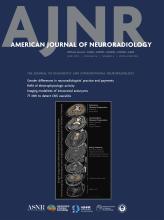Case of the Week
Section Editors: Matylda Machnowska1 and Anvita Pauranik2
1University of Toronto, Toronto, Ontario, Canada
2BC Children's Hospital, University of British Columbia, Vancouver, British Columbia, Canada
Sign up to receive an email alert when a new Case of the Week is posted.
July 2, 2020
Adrenoleukodystrophy (ALD)
- Background:
- Adrenoleukodystrophy (ALD) is an X-linked peroxisomal disorder that involves mainly the nervous system white matter and the adrenal cortex.
- Clinical Presentation:
- It usually presents in childhood to adolescence. Adult onset accounts for 1–3% of all cases.
- Classic symptoms include learning and behavioral problems, vision problems, difficulty swallowing, poor coordination, and Addison disease. In adults, adrenomyeloneuropathy (AMN) is the most common form.
- Key Diagnostic Features:
- Enhancing bilateral symmetric peritrigonal demyelination on MRI is characteristic, but atypical images such as anterior frontal involvement and asymmetric distribution have been occasionally reported.
- The leading edge of demyelination shows enhancement on T1WI+C and restricted diffusion on DWI.
- Bilateral increased signal intensities along white matter tracts (typically corticospinal tract) and cerebellar white matter are seen in 85% and 22% of cases, respectively.
- Cortex sparing, little mass effect, and peripheral enhancement/diffusion restriction are not common findings in tumor or nontumefactive demyelinating diseases. The symmetric lesions in the pons and cerebellum imply inherited metabolic diseases. Physical examination is crucial as the combination of skin bronzing and leukoencephalopathy strongly suggests X-ALD. Further investigation includes gas chromatography-mass spectrometry and gene sequencing.
- Plasma very long-chain fatty acid levels are increased (C26:0 3.89nmol/L [≤1.30 nmol/L] in this case).
- Gene sequencing of ABCD1 detects the most common mutations (c.1780+2T>G in this case).
- Differential Diagnoses:
- GBM: Peripheral and irregular enhancement on T1WI+C. Restricted diffusion on DWI of the more cellular components. Larger lesions will have small flow voids on T2 as a marker of tumoral neoangiogenesis. The infiltrative nonenhancing component usually involves the cortex.
- CNS lymphoma: More frequent in elderly and immunosuppressed patients. Tumors more commonly show low T2-weighted signal and intense homogeneous enhancement on MRI, but in immunodeficiencies, such as Epstein-Barr virus or AIDS infections, heterogeneous peripheral enhancement surrounded by marked vasogenic edema occurs. Significantly reduced diffusion is common.
- Schilder disease: Rare acute demyelinating disease affecting children. Extensive, confluent, asymmetric demyelination in the deep white matter. Typically, the cerebral cortex, cerebellum, brain stem, and spinal cord are relatively spared.
- Tumefactive demyelination: Aggressive demyelination disease. Solitary lesion greater than 2 cm. Enhancement pattern usually takes the shape of an open ring.
- Progressive multifocal leukoencephalopathy (PML): Strongly related with immunosuppressed states. Lesions are multifocal and asymmetric. Subcortical U-fibers involvement is common. No mass effect or enhancement unless in the setting of neuro-IRIS.
- Alexander disease: Frontal white matter lesions with intense enhancement, but brain stem, cerebellar, and spinal cord involvement is characteristic.
- Treatment:
- No cure is available.
- Lorenzo oil may delay symptoms in presymptomatic patients.
- Early bone marrow transplant may stabilize demyelination.











